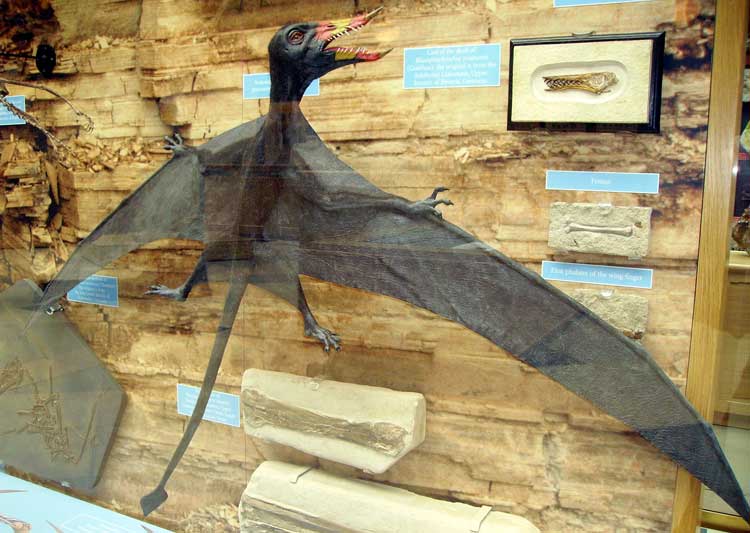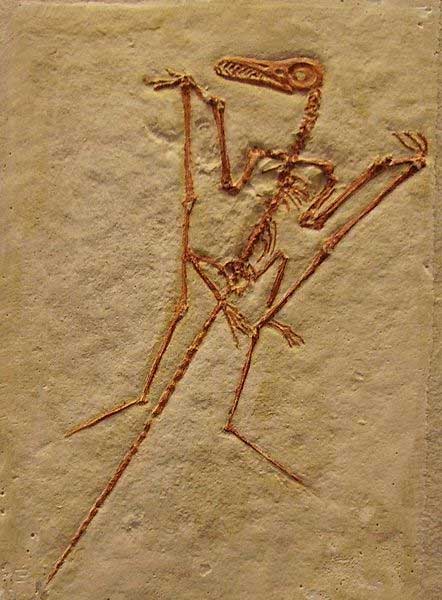Rhamphorhynchus

Rhamphorhynchus model. (*)
| Rhamphorhynchus Fossil range: Late Jurassic |
||||||||||||||
|---|---|---|---|---|---|---|---|---|---|---|---|---|---|---|
| Scientific classification | ||||||||||||||
|
||||||||||||||
| Species | ||||||||||||||
|
||||||||||||||
| Synonyms | ||||||||||||||
|
Rhamphorhynchus (pronounced /ˌræmfəˈrɪŋkəs/) was a genus of long-tailed pterosaurs in the Jurassic period. Its name means 'beak snout'. Only 17.5 cm (7 in) long but with a wingspan of 100 cm (3 ft), it was less specialized than the later pterodactyloids. It had a long tail stiffened with ligaments which ended in a diamond-shaped vane.
Rhamphorhynchus muensteri - Oxford University Museum of Natural History.
Rhamphorhynchus ate fish, frogs,and insects and it is believed that one of the ways it hunted was by dragging its beak in the water, catching fish and tossing them into its throat pouch, a structure similar to that of pelicans, which has been preserved in some fossils. This method of catching fish is found today in skimmers.
Although fossils have been found in England, the best preserved come from the Solnhofen quarry in Bavaria; many of these fossils preserve not only the bones but impressions of soft tissues such as the wings and tail.
Rhamphorhynchus laid eggs instead of giving birth to its young. It belongs to the Suborder Rhamphorhynchoidea.
Species
There are three currently recognized species of Rhamphorhynchus:[citation needed]
* R. muensteri (Goldfuss, 1831) (type)
* R. jessoni (Lydekker, 1890)
* R. tendagurensis (Peck, 1931)
A number of additional species have been named, but are currently considered invalid:

Rhamphorhynchus muensteri - Oxford University Museum of Natural History. (*)
* Rhamphorhynchus longicaudus (Muenster, 1839)
* Rhamphorhynchus gemmingi (von Meyer, 1846)
* Rhamphorhynchus phyllurus (Marsh, 1882)
* Pteromonodactylus phyllurus (Marsh, 1882)
* Rhamphorhynchus longiceps (Woodward, 1902)
* Rhamphorhynchus intermedius (Koh, 1937)
Synonyms
* Pteromonodactylus (Teriaev, 1967)
* Ornithopterus (von Meyer, 1860)
* Ornithocephalus muensteri (Goldfuss, 1831)
* Ornithopterus muensteri (Goldfuss, 1831)
* Pterodactylus lavateri (von Meyer, 1838)
* Ornithopterus lavateri (von Meyer, 1838)
* Pterodactylus longicaudus (Muenster, 1839)
* Pteromonodactylus phyllurus (Marsh, 1882)
* See also the disambiguation page for Rhamphorhynchus.
Anatomy
study in 2003[1] showed that Rhamphorhynchus held its head parallel to the ground due to its inner ear structure, which helped the animal detect its balance, much like humans.
In popular culture
Rhamphorhynchus was featured in the third episode "Cruel Sea" of the award winning Walking with Dinosaurs television series. The reptile is shown living amongst the seaside hunting fish, digging for horseshoe crab eggs and stripping bark off conifer trees to find bark beetle larvae. It is also shown being hunted by Eustreptospondylus. It also appeared in the 1971 film When Dinosaurs Ruled the Earth
References
* Bennett, S. C. (1995). "A statistical study of Rhamphorhynchus from the Solnhofen Limestone of Germany: Year-classes of a single large species." Journal of Paleontology, 69: 569-580.
External links
Retrieved from "http://en.wikipedia.org/"
All text is available under the terms of the GNU Free Documentation License

